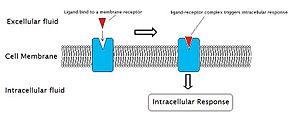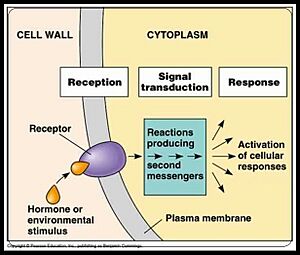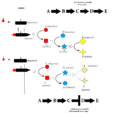Signal transduction facts for kids
Signal transduction is how cells in your body receive and respond to messages. Think of it like a secret code or a relay race inside your cells! It's a process where a cell takes a signal from outside and turns it into a specific action inside.
This amazing process usually happens in two main steps:
- First, a special message molecule connects to a receptor (a kind of antenna) on the cell's outer surface.
- Second, this message is then passed along inside the cell by other molecules, causing a change to happen.
So, signal transduction starts with a signal hitting a cell's receptor and ends with the cell doing something different. What's cool is that the signal can get much stronger along the way. This means just one tiny message can lead to a big response inside the cell!
Contents
How Cells Get Messages
Cells have special parts called receptors that act like ears or sensors. Most receptors are found on the cell's outer skin, called the cell membrane. Part of the receptor sticks out of the cell, and part is inside.
When a chemical signal, like a hormone, touches the outside part of the receptor, it changes the receptor's shape. This change then creates a new signal inside the cell. It's like pushing a button that triggers a chain reaction!
Some message chemicals, like testosterone, are small enough to slip right through the cell membrane. They can then connect directly to receptors floating inside the cell's fluid (cytoplasm) or even inside its control center, the nucleus.
Signal Cascades: A Domino Effect
Often, the signal inside the cell doesn't just go straight to its target. Instead, it sets off a series of signals, one after another. This is called a cascade, like a line of dominoes falling.
With each step in this domino effect, the signal can get stronger. This is why a small initial signal can lead to a very large response from the cell. Eventually, this signal causes the cell to change. It might change how its DNA works in the nucleus or how its enzymes act in the cytoplasm.
Most of the time, these signals involve a fast series of chemical reactions inside the cell. These reactions are carried out by enzymes and linked together by "second messengers." This creates a "second messenger pathway." These processes happen very quickly, sometimes in milliseconds, or they can last for days, like when they change how genes are expressed.
As the signal moves through the cell, more and more proteins and other molecules get involved. This builds up the "signal cascade," making sure that even a small message can create a big effect.
Why Signal Transduction is Important
In tiny living things like bacteria and other single-celled organisms, signal transduction helps them react to their surroundings. It tells them what's happening in their environment.
In bigger living things, like humans and animals, many different signal transduction processes work together. They help coordinate what individual cells do. This way, the whole body can work together in an organized way. The more complex an organism is, the more complex its signal transduction systems need to be.
So, how cells sense both the outside world and what's happening inside them depends on signal transduction. Many health problems, like diabetes, heart disease, and cancer, happen when these signal pathways don't work correctly. This shows how incredibly important signal transduction is for all living things and for medicine.
These cell communication systems are very old. They are found in all animals, showing how basic and important they are for life.
Images for kids
See also
 In Spanish: Transducción de señal para niños
In Spanish: Transducción de señal para niños










